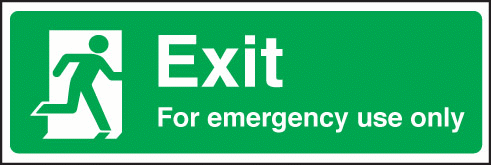Safety Signs Blog
Why there is no such thing as an emergency exit
12th January 2011 | Fire Exit Signs
Posted by David Arnold.
In the UK today there are still a high number of buildings that show fire exit signs that use the phrase ‘Emergency exit’. As you may expect, this is usually to denote the door that is to be used in the event of an emergency. Often this is also just a text only sign, without any running man pictograms. However, as of some 12 years ago (Dec 1998), this is no longer deemed acceptable.
When the Health and Safety (Safety Signs and Signals) Regulations first came out in 1996 it specifically stated that the all fire exit signs must show a “fast walking” man. This man could be one of two designs; either the Eurostyle pictogram (man going towards what looks like a fridge but is actually a door) or the British Standard man seeming stepping through an open doorway:
The British Standards, through BS5499 part 4, took these Regulations and originally stated that best practice was to show supplementary text next to the running man pictogram and arrow (as shown above). However, in the first version of this Standard this supplementary text was an optional extra. To comply with the British Standard back in 1998 you simply had to use the British Standard’s running man going through the open doorway – with or without text:
However, in the early 2000s the British Standard was revised. From this point on, installers that wished to not only comply with the law [H&S (Safety Signs & Signals) Regs] but the British Standard as well had to use fire exit signs with supplementary text. The text used had to be one of the following phrases:
- Fire exit
- Exit
- Exit for emergency use only
As the title of this article suggests, the Standard did not and still does not acknowledge the phrase ‘Emergency exit’.
For advocates of the ‘Emergency exit’ sign, the counter argument put forward is that, with the exception of fire drills, all building evacuations are ‘emergency’ related but not all of them are ‘fire’ related e.g bomb threats, gas leaks etc. However, be that as it may, the Standard is clear. Only the three phrases above can be used.
As has been investigated in a previous article, the definition and difference between an exit and fire exit has long been explored. Signs leading to the front door and any other door used in normal day-to-day working practice should use ‘Exit’ signs. Signs leading to and denoting the door that is only used in the event of an emergency (usually with a push bar or push pad on them) should be marked as ‘Fire exit’. However, the least common of these and slight anomaly is the ‘Exit for emergency use only’ sign. Where should this be used?

Common wisdom is that this sign can be used instead of the fire exit sign. However, in practice, anecdotal research suggests that installers use this sign to denote a secondary door that may be used in the event of an emergency. In other words, the evacuee’s first choice is the doorway or corridor marked ‘Fire exit’. However, if for some reason that exit is blocked, then some installers like the idea of having a secondary means of escape signed should the evacuee require it.
However, as this article reviews, the sign that is certainly not an option for any installer is the ‘Emergency exit’ sign. It turns out there is no such thing!
RESULTS: 4839 PRODUCTS
There are no results for this search
RESULTS: 4839 PRODUCTS
- Categories
- Schools
- Energy Saving
- Fire Safety Signs
- No Smoking / Smoking Sign
- Warning Signs
- Security & CCTV Signs
- No Entry / Restricted Access
- Road and Parking
- Door / Office Sign & Glass Safety
- Signs By Trade / Business
- Signs By Classification
- Fixings and Hanging Kits
- Custom Signs
- First Aid
- Marine & Coastal
- Toilets & Hygiene
- Floor graphics
- Health & Safety Posters
- PPE
- Funny Safety Signs
- Machine Labels
- International Safety Signs
- Seasonal signs
- Housing and Residential
- Welsh Safety Signs
- Dementia Friendly Signs
- Weighbridge Signs
- Electric Vehicle (EV), e-scooters & e-bikes
- NHS signage
- National Trust Brand signs



